#millet bar
Explore tagged Tumblr posts
Text
1 note
·
View note
Text
Energize Your Day with Our Millet Bar: Almond, Foxtail, Dates & Cranberry
Indulge in the goodness of our millet bar - a perfect blend of almond, foxtail, dates, and cranberry. Packed with wholesome ingredients, this millet bar from Upside Health is your tasty, nutritious companion for sustained energy. Elevate your snack game with the power of millets.
0 notes
Text
Introducing GetPhab Chill Mill Millet Wafers
Welcome to the world of GetPhab, where health meets flavor in every bite! Our latest innovation, the GetPhab Chill Mill Millet Wafers, is here to redefine snacking as you know it. Packed with wholesome ingredients and crafted with care, these wafers are not just a treat for your taste buds but also a boost for your well-being.
What Makes GetPhab Chill Mill Millet Wafers Unique?
At GetPhab, we believe in the power of natural ingredients. That's why our Chill Mill Millet Wafers are made from nutrient-rich millet grains, renowned for their health benefits. Millets are gluten-free and packed with essential nutrients like magnesium, phosphorus, and fiber, making them an ideal choice for those seeking a wholesome snack option.
Flavor Fusion at Its Finest
But health doesn't mean compromising on taste! GetPhab Chill Mill Millet Wafers come in a variety of exciting flavors that cater to every palate. Whether you crave the zing of tangy salsa, the richness of creamy cheese, or the aromatic spice of barbecue, there's a flavor for everyone to enjoy. Each wafer is meticulously crafted to ensure a perfect balance of crunch and flavor, making snacking a delightful experience.
Perfect Snack Anytime, Anywhere
Whether you're at work, hitting the gym, or simply relaxing at home, GetPhab Chill Mill Millet Wafers are your go-to snack. They're conveniently packed for on-the-go munching, fitting perfectly into your bag or desk drawer. With their satisfying crunch and guilt-free nutrition, these wafers keep you energized throughout the day without the crash associated with sugary snacks.
A Commitment to Quality
Quality is at the heart of everything we do at GetPhab. Our Chill Mill Millet Wafers are made in state-of-the-art facilities, adhering to stringent quality standards to ensure freshness and flavor in every bite. We source our ingredients responsibly, supporting sustainable farming practices to bring you snacks that are not only good for you but also for the planet.
Join the GetPhab Revolution
Join the growing community of health-conscious snackers who choose GetPhab Chill Mill Millet Wafers for their snack cravings. Whether you're focused on fitness, maintaining a balanced diet, or simply love great-tasting snacks, GetPhab has something for you. Explore our range of flavors, discover the goodness of millet, and elevate your snacking experience with GetPhab Chill Mill Millet Wafers today!
Where to Find GetPhab Chill Mill Millet Wafers
Ready to try GetPhab Chill Mill Millet Wafers for yourself? Visit our website or your nearest grocery store to pick up a pack. Follow us on social media for exciting updates, delicious recipes, and more. GetPhab is here to make snacking healthier, tastier, and more enjoyable than ever before.
Experience the Crunch, Taste the Difference
GetPhab Chill Mill Millet Wafers — because great snacking starts with great ingredients. Embrace a healthier lifestyle without compromising on flavor. Join us in celebrating the goodness of millet with every crunchy bite. GetPhab: Snack Better, Feel Better!
READ MORE...Protein Bars, Protein milkshake, Energy bars Online India | phab
0 notes
Text
Why millets can never get a bad rap
Far from getting a bad rap, the year 2023 has been declared ‘The International Year of Millets’ by the United Nations. As the global agri-food systems face challenges to feed an ever-growing global population, mighty cereals like millet are a saving grace. These are affordable and nutritious options that should be part of your intake.
Unlike rice or wheat, millets have been on the bottom rung of the food system in India and are referred to as coarse cereals — an obvious reference to the external texture which is not smooth. All cereals are a rich source of carbohydrates but millets also come with a higher protein, dietary fibre, iron and calcium content than rice or wheat. This makes it a superfood with enhanced benefits. Millets have a low glycaemic index, which means such foods have a lesser impact on blood glucose levels than other foods. In fact, to help the adoption of millet the Indian government has changed the nomenclature from coarse grains to Nutri cereals.
Millet is a highly adaptable grain that is a great source of protein, fibre, vitamins, and minerals. The potential health benefits of millet include protecting cardiovascular health, preventing the onset of diabetes, helping people achieve and maintain a healthy weight, and managing inflammation in the gut.
Here are some of the top reasons why you should adopt millets in your daily diet :
Millets are rich in phenolic compounds, especially ferulic acid and catechins. These molecules act as antioxidants to protect your body from harmful oxidative stress. This is especially helpful in skin health. Ferulic acid is primarily used to fight off free radicals, which play a role in age-related skin issues, including age spots and wrinkles.
Millets are a great alternative to gluten-rich grains. Millets are a gluten-free grain, making them a viable choice for people with celiac disease or those following a gluten-free diet.
Millets are said to contain soluble fibre, which produces a viscous substance in your gut. In turn, this traps fats and helps reduce cholesterol levels. This helps in lowering the risk of cardiovascular disease.
Regular consumption of millet is beneficial for postmenopausal women suffering from signs of heart ailments, high blood pressure and high cholesterol. They help women to combat the occurrence of gallstones because they are rich in fibre.
Millets are considered an ideal grain for people with diabetes. Since they are rich in fibre and non-starchy polysaccharides, two types of undigestible carbs that help control blood sugar levels, millets are said to have long-term benefits for diabetics.
But did you know, the best way to enjoy the benefits of millet is in a Wild Date snack bar? The Wild Date Beet and Little Millet bar is an excellent vegan option for snacking. It has no added processed sugar, no preservatives and 100% clean ingredients. This particular bar also has rolled oats, coconut flakes, sunflower seed butter, cashew butter, dates and beetroot puree for a wholesome and healthy snack. You can enjoy it on the go, or use it as a meal replacement. Since there is natural nut butter in the snack bar, it is smooth in taste and delicious on the palate.
Still undecided about ‘to millet or not to millet’? Try it for a month and see the difference.
0 notes
Text
a children's bible.
dialogue prompts from a children's bible by lydia millet.
i've got some weed. you want to smoke?
no offense, but i don't have a clue what you're talking about.
discretion is the better part of value.
are you spineless, or just gutless?
you don't win until you're the last one standing.
i had no idea you were so hardcore.
we need 22 garbage bags and plenty of duct tape.
you're dissociating.
jesus, we don't say ____ anymore.
try not to be an assface, for once.
energy bar?
you're flattering me to try to avoid responsibility.
nobody takes the bible literally.
it doesn't feel right here. i know this place.
children grow up. children leave.
they'll find me, when i want them to.
we're not retreating with our tails between our legs.
more importantly, i just don't want to.
my water broke.
you mess up everything. why did you come here?
you have to drive me.
you can always come back.
i'm not sure what we owe our parents.
why are we always complaining? we get to be alive.
i called 911, but i couldn't get through.
it's tough times, isn't it?
i can never read you.
the storm passed.
if we go out there, it should only be to save lives.
i try not to lie.
good job. you really stepped up.
post a lookout at all times.
things felt normal, for a second.
i dreamed about you, once.
i wonder if a makeover would help.
i solve a problem by ignoring it.
you might have hallucinations.
just drink a lot of water and sleep it off.
you're always trying to take care of me.
is that your favorite book?
what did you figure out?
that makes zero sense, small dude.
you can talk?
i'm not going to make out with you.
grab some gear and run.
stay hidden until i come looking for you.
we shouldn't go that far.
you have a very black aura.
don't say i didn't warn you.
i can't give you what i don't have.
i don't say it to claim i'm innocent. i say it because it's true.
they have no idea how good you are.
it's gonna be sunset soon.
he wasn't all bad, my father.
are you too cool for high fiving?
why do you think i ran away?
you're living in a fantasy.
are they going to fix it?
is it the cops?
they broke the rules.
get by the heater, you're freezing.
you shouldn't play with tasers.
who else is there to blame?
what could we have done, really?
i don't think anyone is coming.
do you have somewhere to go?
you gave it the old college try.
chin up, kid. everything's gonna be okay.
you're too young for that responsibility.
it's unhealthy to wallow in everyone else's misery.
i trusted you once.
i'll concede that not everything you say is nonsense.
what happens at the end?
i wish the angels were still with us.
it hurts not to know.
21 notes
·
View notes
Text
(Pt. 2) March 1st/Samil Special: Seodaemun Prison Visit
Daily Life
The prison was both built off of oppression and suffering, and sustained itself this way as well. Seodaemun Prison produced prisoners' uniforms and other textiles, whereas the red bricks to build the facility as well as paper was made by Gyeongseong Prison in Mapo District. If you look closely at some of the bricks, you might be able to see the seal of the Chinese character 京, meaning Gyeongseong.


You can see the conditions that clothing was made in here.

These are the working hours. In total, the average prisoner worked for 10 hours and 30 minutes a day, though the highest recorded time is 14 hours. While commuting from factories to the prison, prisoners were forced to strip naked and jump over a wooden bar to make sure they weren't carrying anything dangerous.
The timetable translated is as follows:
9PM to 5AM: Sleep
5 to 6:30: Morning Routine(wash face, eat food, make way to factory)
6:30 to 9: work
~15min break~
9:15 to 12: work
~30min lunch break~
12:30 to 3: work
~15min break~
3:15 to 6: work
~30min dinner~
6 to 9: clean up, leave


The left picture is a two-story factory. It was originally was 1 big space, and then after 1945, it was divided into 4 spaces. The textiles, thread, and clothes this factory produced was supplied to prisons, militarynunits, and government agencies nationwide.
For meals, it was a composition of 50% soybeans, 30% millet, and 20% brown rice. Depending on a prisoner's rank, they would receive a certain grammage per day.
Special Rank~Rank 4 were prisoners who worked as laborers, and were general offenders, and each meal was from 400(special rank) to 300(rank 4) grams per day. That was about 1,130~850 kcal a day. From Rank 3 upwards, you could send letters to family and friends back home.
After Rank 4, there was Rank 5, Rank 6, Rank 7(people charged with crime of murder), and Rank 8. For them, each meal was from 270~200, about 760~566 kcal per day.
After that were patients. Rank 9(intermediate rank) was given daily meals with less than 220g, about 735 kcal. Then there were patients who were fed porridge or rice, less than 180g and 600kcal.
Generally, it's accepted that meal distribution in reality was much less than what was described on paper.
Torture and Punishment
There were many kinds of torture inflicted onto prisoners. This included fingernail torture, waterboarding, box torture, narrow closet torture, and others. The final punishment for some ended up being execution by hanging, of which this became the fate of approximately 493 martyrs.
There will be images and more description under the cut.



When one was arrested, they would immediately be taken here, to this underground facility. Before interrogation, they'd wait in rooms adjacent to others in which prisoners were being tortured in. The shouting and yelling by other prisoners would serve as psychologically damage, to weaken the spirit of the person as well as instill fear into them. Then the interrogation would begin, and subsequently some tortures. Instead of interrogating arrested persons at the police station, the wardens would dispatch intelligence agents to come directly to the interrogation rooms at the prison.


The left photo was a room for fingernail torture. During interrogation, sharp skewers were shoved underneath the fingernails of prisoners. Previously, this room had models and replicas of what that would look like, but it had to be removed because of how bloody it was.
The second photo showcases different methods. Among these photos are torture equipment, waterboarding, throat torture, and a torture long practiced during the Joseon Era involving placing sticks in between legs and pushing upwards to induce pain. Here's a reenactment that can be found in many museums about the Joseon Era. This specific one is from the Lotte World Folk Museum.


This is a specific kind of box torture involving a wooden box with spikes inside. The person would be placed inside the cramped box, and then violently shook. The second image is an interactive replica, with the spikes closed off by glass. I am 165cm and 42kg, and it was extremely small even for myself. Had the protective glass not been there, I think my back would be resting completely on those spikes.


This was a narrow closet used to torture people by forcing them in. Due to how narrow it is, it's impossible to do anything other than stand. I barely fit inside. Many who tried the experience in the museum have reported being unable to breathe because of how stuffy it was, that they couldn't even last a minute inside.

This was waterboard torture. There were other variations, but this was one of the main ones. In this one, water was poured down the nose and mouth, blocking breathing. There was a high chance of dying in this torture.
There also was something called "Electric Torture" though I can't find much information on it, as well as "Airplane Torture." In total, about 72 methods of torture was inflicted on the prisoners, and those who managed to walk out free mentioned that they feel the aftereffects for the rest of their lives.
I wasn't able to take pictures of the execution building since it's not allowed. I was quite surprised to find someone was able to do this, so I will add their pictures.



The first picture is an entrance with the names of 165 martyrs engraved on them in the shape of the national Korean symbol. Inside is a small shack of sorts, which was where the execution took place in. There were benches for spectators, facing the prisoner to be executed. There was a stool the person would sit on, and the noose would be tied around their neck. In another room, a lever was pulled, causing the trapdoor the stool was on to fall down, causing the person to snap their neck and die.



This is the lever, and the basement access was a set of stairs outside the shack to collect the body. The third picture is what that would've looked like.

This secret passageway was used to carry the bodies out to a cemetery. It's said to be about 200 meters, and in 1992, about 40 meters, or 1/5th of the total length, was restored. These hidden passages were used when the injuries on these bodies were too obvious to hide, when the news of the prisoner's death would cause an uproar in society, or when the dead prisoner had no family or friends to return home to.
The painful bit about the prison is that as you may have noticed, it didn't close down after liberation in 1945. It closed down in 1987, after the military dictatorship finally came to an end. This is because even after the liberation, the subsequent dictatorships set up by the US cracked down on pro-democracy protestors, and many of them were arrested and imprisoned here as well.
The Prison was restored as a museum and opened in 1992 to the public, so they may be reminded of the injustice the Korean people faced during the colonial era and beyond.
The Korean fight for independence and liberation, although only won due to Japan's loss of World War 2, is extremely important as it demonstrates what it means to remain whole and patriotic for your people, and unrelenting in your resistance in any means necessary, may it be bombing the colonial police office in Jongno, Seoul, or assassinating Japanese colonial officers in Shanghai, or by keeping symbols of your culture, like the banned Taegeukgi, and teaching the language in secret.
Many Koreans on this day remember the brave, persistent fight their predecessors put up so that we are able to live the comfortable lives we do today.
대한민국만세!
8 notes
·
View notes
Note
I’m playing a game called “hormonal vs comfy” with my female conure bc she’s only one year old but is up to New And Suspicious things when cuddling like little noises and wing twitches but she also seems young for puberty so I’m on the fence lol.
How does one tell for sure if it’s comfy or hormonal with a conure?
I am also playing this game except it’s modified to “sassy fluff or going to launch across the room to attack me?” Where me and Newt have a standoff in the bird room as I desperately try to fill foragers without getting murdered
The biggest tell for Sus conure activities is usually their booty, if they’re lifting their tail up to wedge in to tight spaces and pressing that booty against anything it’s Horndog Moments. This can include sitting lower on perches and outright rubbing that cloaca on things.
Anything to do with dark cavities, sticking their head in them, being aggressive about them, being obsessive about finding a dark spot
In terms of if it’s comfy body language vs sus body language it is a bit of a learning curve for each individual bird. With Newt you can notice it’s a more disgruntled fluff where he may be gently vibrating his feathers and making raspier “grouchy” vocalizations. But all birds will have minute differences on how they present that. He’ll also do a screech and pluck a nearby object like cage bars or the ground if he’s more irritable bc of hormones
If some thing feels off to you it’s definitely best to redirect the behaviour than not. Having a solid recall cue and some easy activities nearby help to disengage them from whatever horny thing they’re doing and get their brain focused on something else. An easy thing to have on hand is twine balls stuffed with millet. They can crunch out some of that frustration and be motivated by the treats inside to keep going instead of zipping back to Inappropriate Things
#he calmed for a few weeks#and now soiled back up again#but our weather got super warm this week#so it makes sense lmao#hormone ask
27 notes
·
View notes
Text
Always perplexed by granola bars that use millet as a primary grain. I am not a parakeet.
4 notes
·
View notes
Text
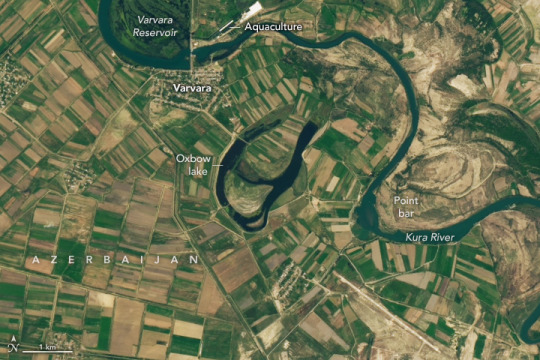
A is for Azerbaijan
The headwaters of the Kura River, Azerbaijan’s longest waterway, lie in the mountains of northeastern Türkiye. From there, the Kura winds through the forested hills and valleys of the Lesser Caucuses before turning east and heading toward Tbilisi, Georgia’s capital. The river continues westward into Azerbaijan and drains eventually into the Mingachevir and Varvara reservoirs, which were built by the former Union of Soviet Socialist Republics in the 1940s and 1950s, respectively.
Suspended sediment, silty banks, and a shallow downstream gradient encourage growth of the winding, snake-like curves and bends in the river known as meanders. Water flowing through these bends tends to be deeper and flow more quickly along the outer edge, where it carves a cutbank, while shallower, slower-moving water deposits a point bar along the inner edge. Over time, the bends can become so sharp and elongated that the river loops back onto itself and cuts the meander off, forming a separate U-shaped (or C-shaped) body of water called an oxbow lake.These erosional processes formed the curvy, A-shaped lake shown above. The A’s cross-hatch likely formed before the lake separated from the main river channel. As the bend elongated, the river likely formed a new, more direct channel bisecting the bend. The OLI-2 (Operational Land Imager) on Landsat 9 acquired this image on September 2, 2024. The image below shows a broader view of the same area.

That A-shaped lake, known locally as Ozero Akhmaz, is one of several oxbow lakes flanking the main channel of the river. These isolated features typically display darker blue water because they contain less suspended sediment than the main channel of the river.
While natural processes often form meanders and oxbow lakes, human activity has also transformed the landscape. In addition to dams, a network of canals runs through the scene on both sides of the river, conveying water to farmland and towns. This irrigation system makes it easier to grow a variety of crops, including cotton, barley, millet, wheat, sunflowers, fruits, and vegetables, in the region’s cold, semi-arid climate.
Industry including textiles, manufacturing, and mining are also present, particularly in and around Mingachevir, a growing city that is now the fourth-largest city in Azerbaijan. Fishing and intensive use of the river have reduced the number of species that live in the Kura, but there are efforts to replenish some species. The fish farm visible on the north bank of the river (top image), for instance, raises sturgeon and herring to bolster populations of these prized animals.

Lake Akhmaz is one of dozens of letter-shaped features on Earth’s surface curated by NASA’s Landsat outreach team. The images are part of an interactive tool that allows users to compose names or other words using Landsat images of Earth. For more information about some of the letters, see Earth Observatory’s 2012 Reading the ABCs from Space story.
NASA Earth Observatory images by Wanmei Liang, using Landsat data from the U.S. Geological Survey. Story by Adam Voiland.
2 notes
·
View notes
Text

MWW Artwork of the Day (9/29/23) Vincent Van Gogh (Dutch, 1853-1890) Wheat Fields with Reaper at Sunrise (Sept. 1889) Oil on canvas, 79 x 92 cm. Van Gogh Museum, Amsterdam
This painting depicting a reaper in a sun-drenched wheatfield was painted in Saint-Rémy, a small village near Arles. In the wake of several mental crises, Van Gogh had decided to commit himself to the hospital there at the end of April 1889. He was treated by Dr. Peyron, who gave him permission to continue painting. Van Gogh worked in the garden, drew the hospital’s corridors and barred windows, painted the view from his cell, and made several portraits of other patients. Occasionally, he was allowed to venture outside the hospital walls, but never alone. When he could not work outdoors he made his own variations on the paintings of Millet, Delacroix and other masters.
10 notes
·
View notes
Text
Tilling the fields, QMYS, Section 1
The Qimin yaoshu齊民要術 (“Essential Techniques for the Common People) by Jia Sixie (fl. c. 540), is the oldest Chinese agricultural treatise to survive in its entirety. Jia Sixie served as a mid-level official of Eastern Wei,as such the focus is on the dryland farming practices of his home region in modern Shandong rather than the wet rice agriculture of Southern China. The book itself mixes Jia Sixie's own advise and descriptions with quotations from earlier works, many of which are now lost. The QMYS is therefore not just an important source for the author's own times, but for the agricultural writings and practices of the preceding centuries.
Section 1 covers the different aspects of tilling the fields in preparation for cultivation, and contains advise for how to clear new fields, ploughing, harrowing, different soil types, and so on.
(To go straight to the translation, jump to "Section 1, Tilling the Fields")
[Translator's preface]
[The QMYS is not illustrated, but texts of this nature really should come with some visual aides. I have therefore included here some drawings and pictures from later eras. All images from Wikipedia.
[Farming tools]
Han era scholars agreed that China's first plough had been a tool called leisi耒耜, but lacked a clear of concept of how it actually looked like. Later authors simply repeated their statements. The drawing below from Wang Zhen's (1271-1333) Nongshu is therefore at best a reconstruction from literary evidence.
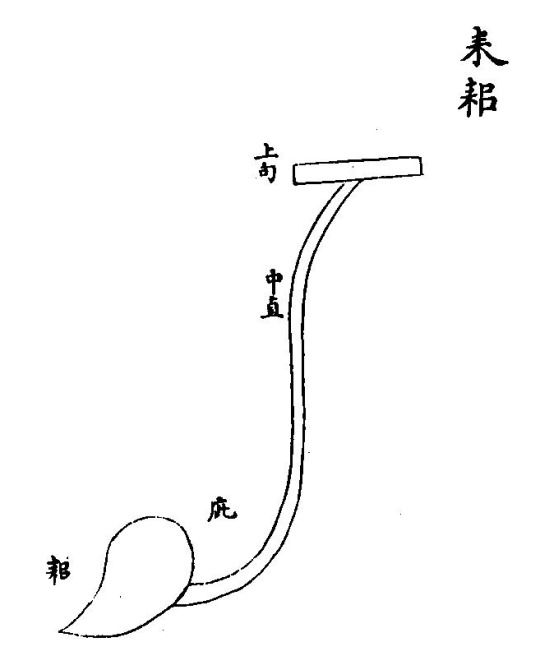
(Leisi耒耜, from Wang Zhen's Nongshu)
The main plough was instead the ox-pulled li犂 frame-plough.

(Li犂, from Wang Zhen's Nongshu)
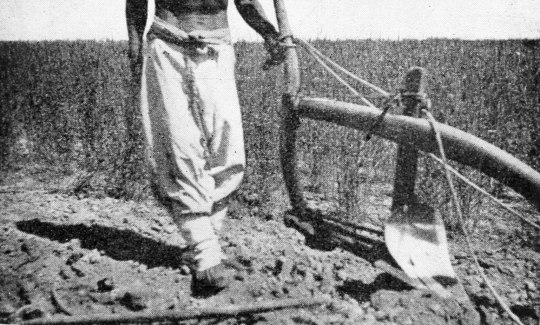
(Shantung plow, from King, 1911, Farmers of forty centuries)
QMYS also refer to the lighter feng鋒 plough.

(Feng鋒, from Wang Zhen's Nongshu)
The QMYS is the oldest Chinese text to refer to the iron-tined harrow, which it refer to as loucou𨫒楱

(Ba耙, from Wang Zhen's Nongshu)
The lao勞 bush-harrow was made by weaving thin sticks around the cross-bars.
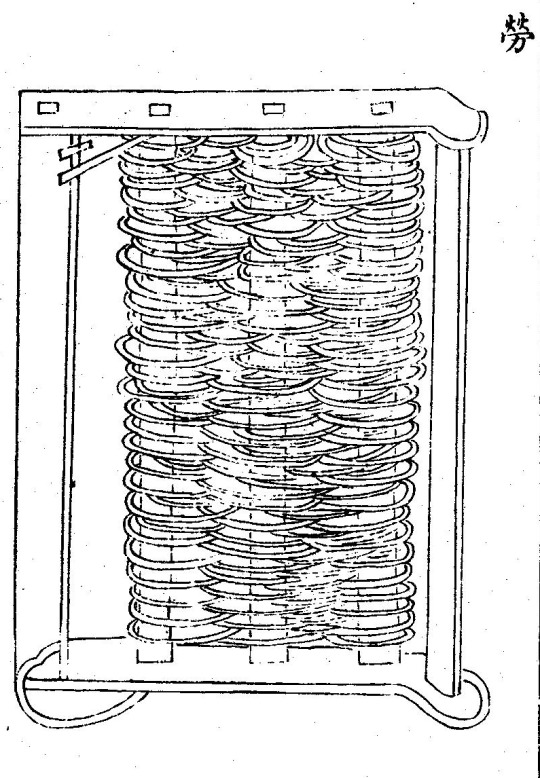
(Lao勞, from Wang Zhen's Nongshu)
The preferred tool for sowing was the seed drill, lou耬
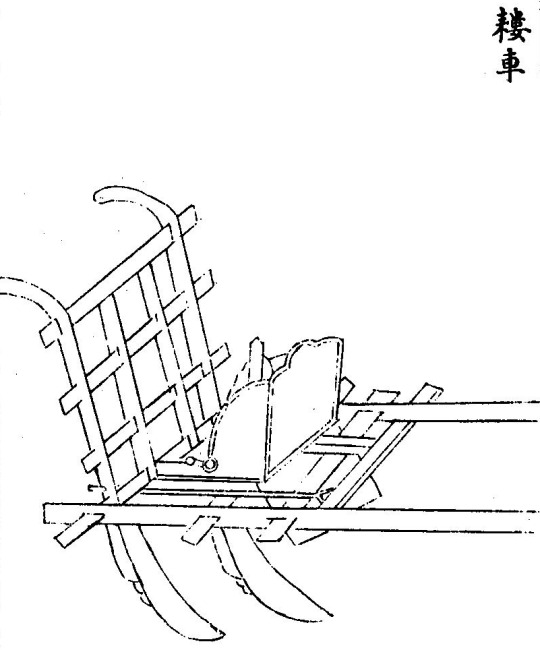
(Louche耬車, from Wang Zhen's Nongshu)
In addition to these ox-drawn tools, there were of course a varity of manual tools in different shapes and sizes, hoes, shovels, etc.
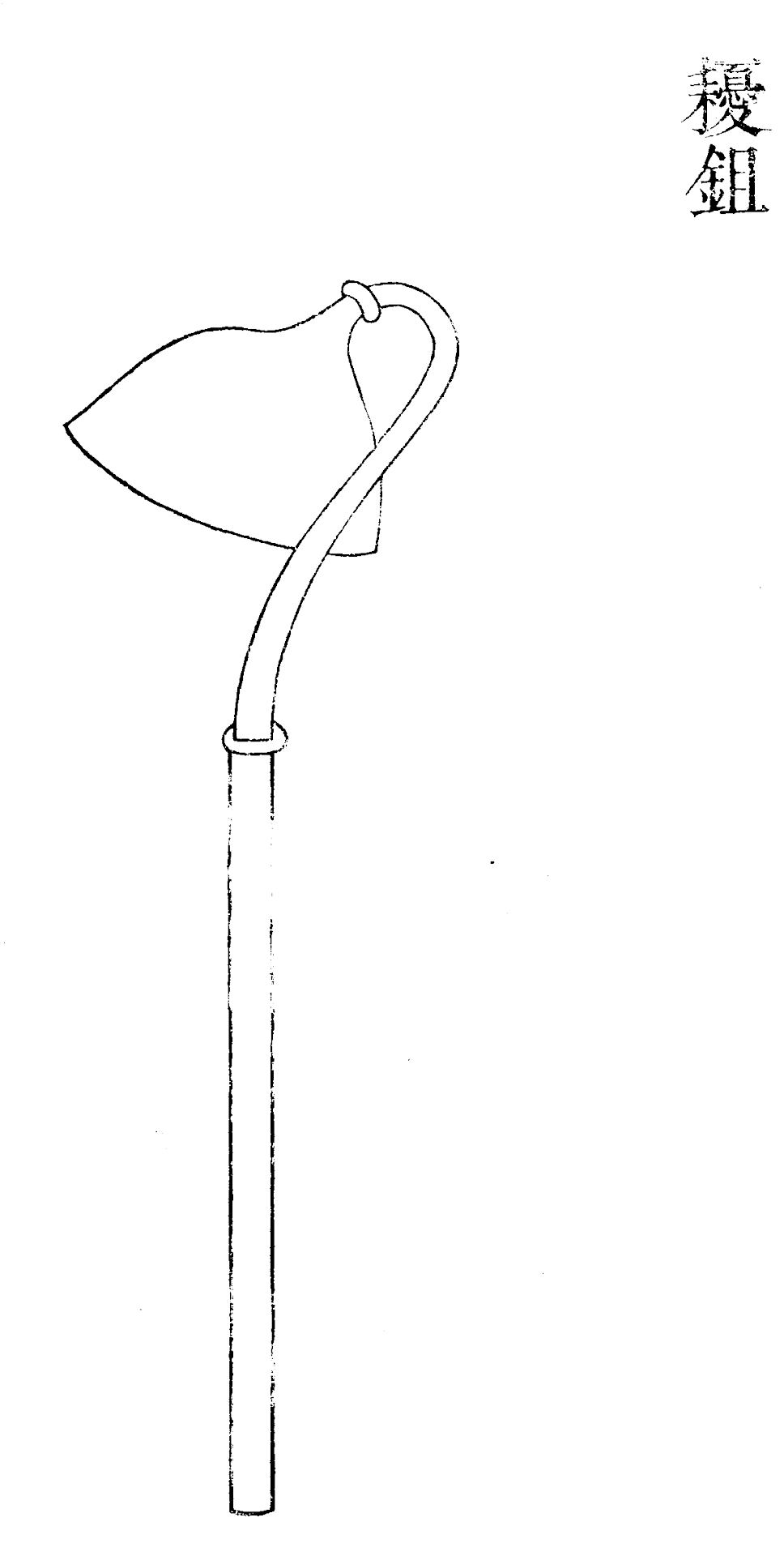
(Youchu耰鋤, from Wang Zhen's Nongshu)
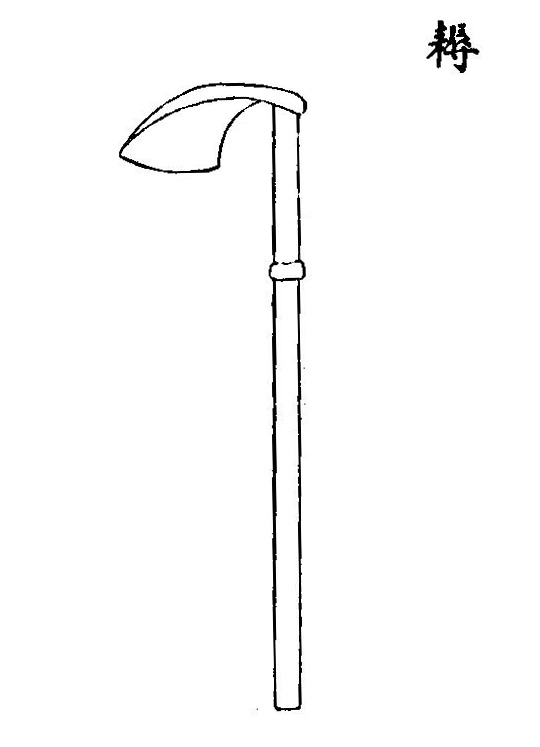
(Nou耨, from Wang Zhen's Nongshu)
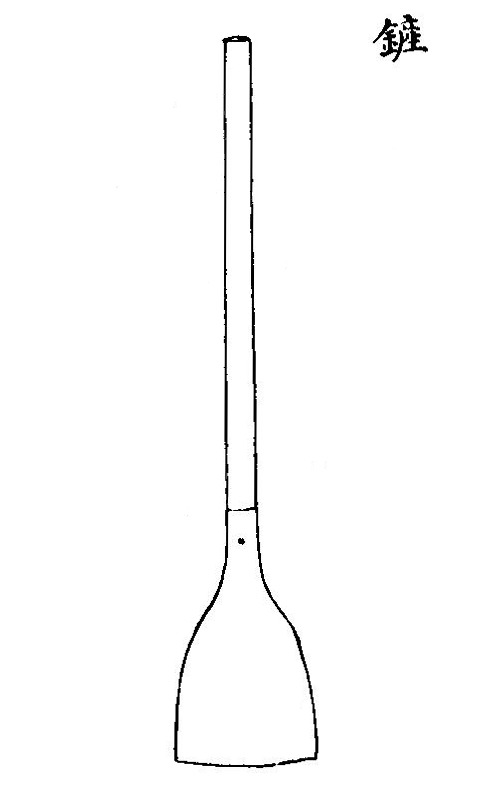
(Chan鏟, from Wang Zhen's Nongshu)
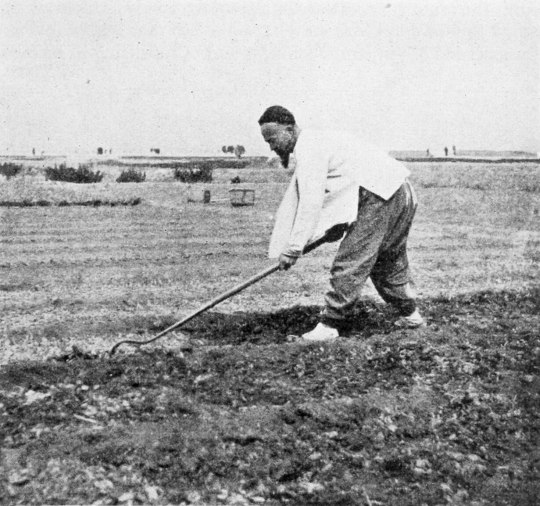
(Method of using the broad, heavy hoe in producing surface mulch, as seen in Shantung, China, from King, 1911, Farmers of forty centuries)
[Crop plants]
Later sections of QMYS treats the cultivation of the individual crops in much larger detail.
Foxtail millet (Setaria italica), gu穀, was the main staple crop.

Broomcorn millet (Panicum miliaceum), shu黍
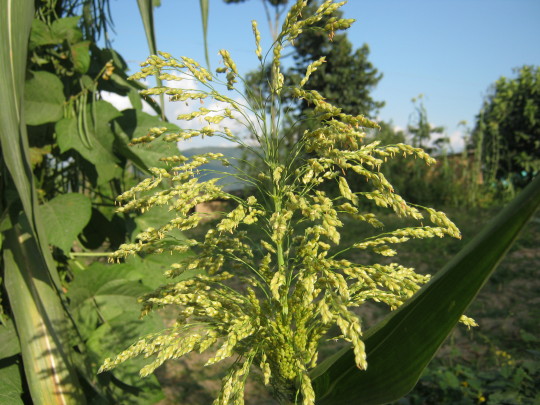
In addition to gu and shu, different varieties of foxtail and broomcorn millet were known under a large number of other names.
Mung beans or green gram (Vigna radiata), lüdou緑豆 (lit. "green beans"), used as green manure in crop rotation with millet

Adzuki beans (Vigna angularis), xiaodou小豆 (lit. "small beans") served a similar function
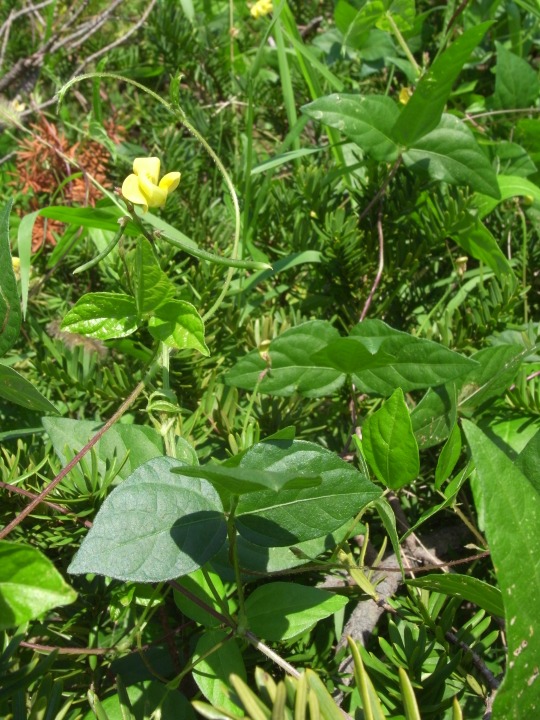
Wheat (Triticum aestivum), mai麥 (same name also used for barley) was primarily a winter crop in ancient China.

[Books quoted by QMYS in Section 1, in order of appearance]
The Zhoushu周書 (“Book of Zhou”), also known as the Yi Zhoushu逸周書, is a Warring States era collection of documents about Western Zhou, but the book has a complicated textual history. It is quoted once in QMYS, in Section 1. The quoted text is not found in the transmitted version.
The Shiben世本 (“Generational Roots”) records the genealogies of mythical rulers, the origin of the clan names, and mythological and historical inventors. Several versions existed, by different authors. The full text now lost, but it is quoted numerous times in other works. It is quoted once in QMYS, in Section 1.
The Lüshi chunqiu呂氏春秋 (“Spring and Autumn of Mister Lü”) is a collection of treatises and essays attributed to the retainers of Lü Buwei, the (in)famous Qin chancellor. It covers a very wide range of topics.
The Erya爾雅 (“Approaching the Correct”) is the oldest surviving Chinese glossary. Modern scholarship dates the book to the late Warring States and/or early Western Han periods. It is quoted numerous times in QMYS.
The Jianwei shiren犍為舍人, the “Retainer from Jianwei”, lived during the reign of Emperor Wu of Han and wrote a commentary on the Erya. The book is now lost. The quote in Section 1 is the first of three in QMYS.
The Zuanwen 纂文 (“Compiled Graphs”) by the Liu-Song scholar and historian He Chengtian何承天 (370 – 447) is now lost. It is quoted once in QMYS, in Section 1.
The Shuowen 說文 (“Explaining Graphs”) by Xu Shen許慎 (c. 58 – c. 147) analyses the composition and reasoning behind the different characters. It is quoted numerous times in QMYS.
The Shiming釋名 (“Analysing Names”) by Liu Xi劉熙 is a glossary in the style of the Erya written c. 200 AD. The quote in Section 1 is the first of three in QMYS.
The Liji 禮記 (“Ritual Records”) is a collection of ritual treatises compiled from older texts during Former Han, it became part of the textual canon as one the Five Classics and also as one the Three Ritual Classics. Its usage in QMYS is restricted to the Yueling chapter.
The Yueling月令 (“Monthly Orders”) chapter of the Liji is a calendrical treatise describing for each of the twelve months the position of the stars and other seasonal markers, important state rituals, and which activities should be undertaken in each month. Its inclusion in the Liji ensured it what read by every person aspiring to an education and it inspired a whole genre of similar texts, such as the Simin yueling. It is extensively quoted in QMYS.
Zheng Xuan鄭玄(127 – 200) was a famous scholar at the end of Han who wrote an influential commentary on the Three Ritual Classics. In QMYS quotations from the Yueling and Zhouguan are usually accompanied by quotes from his annotations.
Mengzi孟子 (“Master Meng”, theLatin Mencius) collects the teachings of the famous Warring States era philosopher Meng Ke (372–289 BC). The quote in Section 1 is the first of three in QMYS.
Wei Wen-hou魏文侯, Marquis Wen of Wei, ruled Wei during the early Warring States era. The single quote in QMYS attributed to him is found in the Huainanzi.
The Book of Miscellanea on Yin and Yang雜陰陽書 was apparently written during the early Han, but is now lost outside the quotations in the QMYS. The quote in Section 1 is the first of eight in QMYS.
Gao You高誘 lived at the end of Han and wrote commentaries on several texts, including the Lüshi chunqiu and the Huainanzi. The quote in Section 1 is the first of eight in QMYS.
The Huainanzi淮南子 (“Masters of Huainan”) is a collection of philosophical treaties compiled during Western Han at the court of Liu An (179 – 122 BC), vassal king of Huainan. It covers a wide range of topics. The quote in Part 9 is the second of nine in QMYS, the first being in the preface (which I have impudently skipped).
The Fan Shengzhi shu氾勝之書 (“Book of Fan Shengzhi”) is the oldest known Chinese agricultural treatise. Fan Shengzhi might originally have been an easterner, but during the early Western Han served as an official in the Guanzhong region. The original book has been lost, but it is extensively quoted in the QMYS, and also by Tang and Song encyclopedias.
Cui Shi崔寔 (d. c. 170) was a Han official and author of multiple works, including the Simin yueling and Zhenglun.
The Simin yueling 四民月令 (“Monthly Orders for the Four People”) is written in the style of the Liji Yueling, detailing each month's agricultural activities at the large estates of late Han North China. The original book is lost except as fragments in other books. It is very extensively quoted in the QMYS.
The Zhenglun政論 (“Essay on Government”) criticizes what Cui Shi considered the decline in morals and lax administration of law in his time. The original book is lost except as fragments in other books. It is quoted once in QMYS, in Section 1.
[Lettered notes]
The original text is a mix of large and small characters. I have collected the small text sections together in idented lettered notes within {} brackets.]
[Translation starts here:]
Section 1, Tilling the Fields
[Dictionary definitions]
The Book of Zhou says: “In the time of the Divine Farmer, Heaven rained millet [su粟]. The Divine Farmer thereupon tilled and planted it. He created pottery, cast axes and hatchets, and made the plough-shaft and ploughshare [leisi耒耜], the long- [chu鉏] and short-handle hoe [nou耨], to clear the grass and thickets. Afterwards the Five Grains supported and helped, and the Hundred Fruits were stored in abundance.”
The Generational Rootssays: “Chui created the plough-shaft and ploughshare. Chui was a vassal of the Divine Farmer.”
The Spring and Autumn of Mister Lüsays: “The ploughshare is six cun wide.”
The Eryasays: “To mow[qu斪] or weed[zhu斸] are spoken of as to settle [ding定].”
The Retainer from Jianwei says: “To mow or weed is to hoe [chu鋤]. They are names for settling.”
The Compiled Graphssays: “In the way of tending sprouts, the long-handle hoe [chu鋤] is not as good as the short-handle hoe [nou耨], the short-handle hoe is not as good as shovel [chan鏟]. A shovel is two chi long, with a blade two cun wide, and is used to level the ground and remove grass.”
Xu Shen's Explaining Graphssays: “The plough-shaft [lei耒] is for hand-tilling with a curved wood. The plough-share [si 耜] is the plough-shaft's straight end. The weeder [zhu斸] is for cleaving [zhuo斫]. In Qi they speak of it as the ziji鎡基. Some say the axe handle [jinbing斤柄] is curved by nature. A field [tian 田] is laid out [chen陳]. Where is planted grain is called a field. [The graph] resemble four 口, and the 十 is the pattern of paths and cross-paths. To till [geng耕] is to plough [li犂]. [the graph] comes from “plough-shaft” 耒 with the “well” [jing井] sound. Some say it is the ancients' well field [system.]”
Liu Xi's Analysing Names say: “A field [tian田] is full [tian填]. The five grains fill up within it. A plough [li犂] is profit [li利]. To profit, turn over the soil and cut off the grass at the root. The short-handle hoe [nou耨] resembles hoeing [chu鉏], with crouched back hoe among the stalks. To weed out [zhu] is to execute [zhu誅] someone. The ruler uses execution to dig up a matter at the root.”
[General advise]
In general, when opening uncultivated mountain and marsh fields, always in the 7th Month cut down and mow them. When the grass has dried, set fire to it. Arriving at spring, begin to clear out those of its groves where the wood is large, peel off the bark to kill them. When the leaves are dead and not casting shadow, they will readily yield to tilling and planting. After three years, when the roots have withered and the stalks decayed, use fire to burn them (entering the ground fully), till the uncultivated land to the end, and use an iron teeth loucou𨫒楱 harrow to rake it twice everywhere, hurl broomcorn non-glutinous millet, and bush-harrow [lao勞] it again twice everywhere. Next year then it is fitting to be a millet field.
In general when tilling eminent or inferior fields, do not ask about spring or autumn, [you] must pay attention to dry or wet to obtain what will be good. If flood and drought are not in concert, it is better with dry and not wet {A}. For the spring tilling, immediately take in hand the harrowing{B}. For the autumn tilling, wait for the turn to white to harrow{C}. [When the soil starts to dry, the surface turns white, which Jia Sixie refers to as 白背.]
{A: With dry tilling, then even if there are earth-clods, as soon as there is rain, the earth will pulverize and dissolve. With wet tilling, it will harden when it dries, and for several years will not be good. The proverb which says: “Wet tilling and damp hoeing is not as good as going home.” tells that it is of no gain and will be damaging. In the case of wet tilling, when it turns white quickly use the loucou on it, and there will likewise be no injury. If not done, it will be very bad.} {B: The ancients said you耰, now we say lao勞. The Explaining Graphs says: “The you is a tool for rubbing [mo摩] the fields.” Now people also name the lao bush-harrow a “rubber” [mo]. A vulgar saying is “till the field with the rubbing harrow”.} {C: During spring, there is much wind, and if [you] do not soon harrow, the earth will surely be empty and dry. During autumn the fields are soaked solid, and wet harrowing will make the earth stiff. The proverb which says: “To till and not to harrow is not as good as making it go to waste” perhaps tells that wetlands are difficult to handle, and delights in Heaven's timely chances. Huan Kuan's essay on Salt and Iron says: “Underneath a thick grove there is no lush grass. Between large clods there are no excellent sprouts.”}
In general, autumn tilling want to be deep, spring and summer tilling want to be shallow. Ploughing want to be narrow, harrowing want to be double{D}. In the autumn to till and cover over what is green is the best.{E} The earliest tilling want to be deep, and the turned over earth want to be shallow.{F} On land with themeda or cogon-grass [jianmao菅茅], [you] ought to let loose cattle and sheep to trample it. Then if in the 7th Month [you] till it, it will die{G}.
{D: Plough narrow and till finely, the ox then will not tire. Double-harrow and the land will ripen, during drought it will likewise protect the moisture.} {E: Reaching the winter months, the green grass that has regrown will be as excellent as adzuki beans [xiaodou小豆].} {F: If the tilling is not deep, the land will not ripen. If the turned over is not shallow, the stirring will bring forth the soil.} {G: If not the 7th Month, it will regrow.}
In general, the rule for excellent fields, is for mung beans [lüdou緑豆] to be first, adzuki beans and sesame [huma胡麻] is next to it. Thoroughly for all of them sow densly [?] within the 5th and 6th Months, and in the 7th and 8th Month plough and cover over to kill them. [This] will make a spring millet field with a harvest of ten shi on the mu, in excellence comparable to silkworm excrement and mature manure.
In general, after the autumn harvest, the oxen's strength will be weak. For those not yet caught up for autumn tilling, at the bringing down of [?] the foxtail [ gu穀], glutinous broomcorn [shu黍], non-glutinous broomcorn [ji穄], large grained [liang 粱], and glutinous foxtrail [shu秫]millets' stubble, then move the exhausted ones to quickly use the “spear-point plough” [feng鋒] on it. The ground is regularly soft and moist, and is not hard and tough. Then when arriving at the beginning of winter, [you] usually get to till and harrow, and not worry about it being dried up and arid. If the oxen's strength is small, only harrow it once during the 9th and 10th Months, and arriving at spring, sow without ploughing [?], is also doable.
[Excerpts from the Monthly Orders on tilling]
[This whole subsection consists of quotation from the classic text the Monthly Orders [Yueling 月令], a chapter of the Ritual Records [Liji禮記], accompanied by quotations from commentary by the Eastern Han scholar Zheng Xuan.]
The Ritual Records' Monthly Orderssays: “In the Month of First Spring, … the Son of Heaven therefore on the inaugural day pray for grain to the High God [shangdi上帝]{H}. Then, selecting the inaugural chen day, the Son of Heaven personally conveys the plough-shaft and ploughshare. … He leads the Three Excellencies, the Nine Dignitaries, the various feudal lords, and the great men, to till themselves the God's Acre [Di ji帝籍]{I}. This Month, Heaven's breath descends down and Earth's breath rises up. Heaven and Earth are in harmony with each other, and the grasses and trees sprout and stir{J}. … He instructs the ministers for the fields{K}. They skilfully assess the hills and mounds, the slopes and defiles the highlands and lowlands, for what is suitable among the land and ground, and what to plant of the Five Grains, so as to teach and guide the people. … Field affairs having been put in order, he first settles the guidelines and responsibilities. Agriculture was therefore not in confusion. ...”
{H: Zheng Xuan's Annotations says: “It speaks of the first xin day, and the suburban sacrifices to Heaven. The Spring and Autumn Transmittals says: 'In spring the suburban sacrifices to the Lord of Agriculture [Houji后稷] to pray for farming affairs. Thus after the commencement of hibernation, the suburban sacrifices. After the suburban sacrifices, the tilling.' The High God is the god of the Grand Tenuity [taiyi太微].”} {I: “Inaugural chen is perhaps a propitious chen day after the suburban sacrifices. … The God's Acre is the field by which is regulated the Heavenly Divinity's lending the people strength.”} {J: “This is the yang breath ascending through the surface, a portent that there can be tilling. The Book of Agriculture says: 'For the best growth cover over the stakes. When they show the base and can be pulled out, those who till urgently set out.”} [This Book of Agriculture [nongshu農書] is apparently the same as the Book of Fan Shengzhi which is quoted in more detail on this topic further down.] {K: “With minister it speaks of the 'field surveyors', the officials in charge of agriculture.”}
“In the Month of Middle Spring, … those who till have a short rest, they then repair their gate and door leaves [heshan闔扇]{L}. There are no great affairs undertaken which would hinder agricultural affairs. … ”
{L: 'Rest' [she舍] is similar to 'pause' [shi止]. Hibernating insects open doors, and with tilling affairs a little tranquil, they then put in order their gates and doors. When they use wood it is called he闔, when they use bamboo or reeds it is called shan扇.”}
“In the Month of First Summer, … he encourages agriculture and motivates the people, and there are not anyone who neglects the season{M}. … He instructs the farmers to apply themselves to action, and not rest at the capital{N}. ...”
{M: “He puts weight and effort in encouraging [them?] to come to him.”} {N: “He presses and urges the farmers. … The Rites for the King Residing in the Bright Hall says: 'There are no sojourners in the state'.”
“In the Month of Last Autumn, … The hibernating insects altogether curl up inside, and everyone plaster their doors.{O}”
{O: “With 'plastering' [jin墐] it speaks of smearing plaster [tu塗] to shut them. This is to avoid the killing[?] air.”}
“In the Month of First Winter, … Heaven's breath rises up and Earth's breath descends down. Heaven and Earth do not communicate, they shut up and hide, and achieve winter. … He encourages the farmers to rest and comforts them{P}. …”
{P: “'The Ward Corrector [dangzheng黨正]' 'drinks wine with the people belonging to him, and correctly arrays their ranks.'”} [Zheng Xuan here quotes from the Rites of Zhou]
“In the Month of Middle Winter, … ground affairs are not undertaken, care is taken not to open up what is covered, and not to open rooms and buildings. … [otherwise] the Earth's breath would further spill out, this is spoken of as opening the house of Heaven and Earth. The various hibernating [insects] would then die, and the people would be ill and sick{Q}. …”
{Q: “When the Great Yin employed in affairs, it especially puts weight on closing up and keeping safe.” Note that in the present era's tilling in the 10th and 11th Months is not straightly disobeying the Way of Heaven, and harming hibernating insects. [If] the earth likewise was not made moist, the harvest would surely be meagre and small.} [The words “Note … small” are not part of Zheng Xuan's commentary, but are rather Jia Sixie's own comments.]
“In the Month of Last Winter, … he instructs the field officials to announce people to bring out the Five Seeds{R}. He instructs the farmers to plan their plough-pairs and tilling affairs, repair their plough-shafts and -shares, and prepare their field tools{S}. … This month, the sun has gone through the stations, the moon has gone through the positions, and the stars have cycled around Heaven. The numbering is soon about to end{T}. The year will once more begin. Pay attention to your farming people, and do not have them sent about{U}.”
{R: “He instructs the field officials to announce to the people to bring out the Five Seeds. The great cold has passed by, and farming affairs are about to begin.”} {S: The ploughshare [si耜] is the metal of the plough-shaft [lei耒]. The ploughshare is five cun wide. Field tools are the types of hoes [ziji鎡錤].” {T: “It tells that the sun, moon, and stars have travelled around until this month, when they all have made a circuit to their old locations. The 'stations' [si次] are the lodges [she舍]. The 'positions' [ji紀] are similar to lodges.”} {U: “er而 [“thy”] is similar to ru汝 [“you” or “your”]. It tells to pay attention solely to the hearts of your farming people, and make people prepare their resolve for the affairs of tilling and sowing. It is not possible to conscript them for labour. If conscripted for labour, their resolve will scatter, and they will neglect their profession.”}
[Other quotations on tilling]
Master Meng says: “A gentleman's assignment is like a farmer's tilling.”{V}
{V: Zhao Zhu's annotations says: “It tells that to be hasty in your assignment, like a farmer who does not till, is impossible.”}
Marquis Wen of Wei says: “People in spring put their effort into tilling, in summer use their strength for weeding, and in autumn they gather their harvest.”
The Book of Miscellanea on Yin and Yang says: “When on hai亥 it is in the Heavenly Granary constellation, it is the start of tilling.”
The Spring and Autumn of Mister Lü says: Fifty-seven days after winter solstice, sweet flag [chang昌] grows. Sweet flag is the first to grow of the hundred hundred grasses, and at this point tilling starts.
The Masters of Huainan says: That which does the affairs of tilling is toil, that which does the affairs of weaving is trouble [?]. They are affairs of toil and trouble, yet those people who do not rest know they can be used for clothes and food. A person's feelings are not capable of being without clothes or food. The way of clothes and food surely starts at tilling and weaving. … Those who, if they till and weave, who will start at the beginning with considerable toil, and end with certain profit, are the multitudes.
It also says: “To be unable to till and yet want glutinous broomcorn or large grained millet, to be unable to weave and yet want to sew attires, to have nothing in their affairs and yet seeking their merit, is difficult.”
[Quotations from Fan Shengzhi]
The Book of Fan Shengzhisays: “In general, the root of tilling lies in determined timeliness, harmony with the ground, applying oneself to manure and moisture, and to hoe early and harvest early.”
“At spring when the frost disperse, Earth's breath starts to permeate, and the soil's sole harmony disperse. At the summer solstice, Heaven's breath starts to heat, the yin breath starts to flourish, and the soil again disperse. Ninety days after summer solstice, when day and night are split, Heaven and Earth's breath are in harmony. Using these times to till the fields, one will yield five, which is called fertile bounty, all then are times for work.”
“At spring when the Earth's breath permeates, [you] can till the hard and tough earth with black, lumpy soil, immediately level and rub down its clods to give growth to grass. When the grass grows, again till it. When the sky has a little rain again till and harmonize it. Do not make that which has clods await the season. This spoken of as 'if strong soil, then weaken it'.”
“A spring portent that the Earth's breath has started to permeate: Hammer down wooden stakes, a chi and two cun long, cover over a chi [so that you] see two cun. After the advent of spring [lichun立春], the soil clods will break up, and the top will slide down the stakes. When they show the base, and can be pulled out, after twenty days from this time, the harmonious breath will leave, and promptly the soil will stiffen. With timely tilling, one will yield four; till when the harmonious breath has left and four will not yield one.”
“When the apricots start to flower and flourish, immediately till light soil and weak soil. Wait for the apricot flowers to fall off, and then till again. Till and immediately roll it [lin藺]. When grass grows, and there is rain and moisture, till and heavily roll it. For soil that is particularly light, use cattle and sheep to trample it. Like this the soil will strengthen. This is what spoken of as 'if weak soil, strengthen it'.”
“If at the spring breath is not permeated, soil fully fitting will not protect its moisture, and for the remainder of the year will not be suitable for sowing, and no manure will not dissolve [?]. Take care to not till dry land. Wait for grass to grow, and to arrive the time it can be tilled. When there is rain, promptly till it, The soil will be close with each other, sprouts only will grow, grass and weed will rot, and [you] will always achieve good fields. This way one tilling will yield five. If not done like this, but dry tilled, clods will be tough, sprouts and weed will spring forth from the same hole and will be impossible to hoe into order, and and it will turn around to become failed fields. If in autumn with no rain [you] yet till, it will sever the soil's breath, and soil will be hard and dry. These are called 'arid fields' [latian臘田]. And when you till in severe winter, [you] will leak out the yin breath, the soil will wither and dry out. These are called 'parched fields' [futian 脯田]. Arid fields and parched fields are both wounded fields. If for two years they do not produce sheaves of grain, then rest them for a year.”
“In general wheat [mai麥] uses the 5th Month for tilling. The 6th Month is second for tilling, and in the 7th Month [you] must not till. Carefully rub and level to await the time for sowing seeds. Till in the 5th Month, one will yield three. Till in the 6th Month, one will yield two. If tilled in the 7th Month, five will not yield one.”
“In winter when the rain and snow has stopped, immediately roll it down. Trap the snow in the soil, and do not cause the following wind to fly away with it. If it snows later, roll it down again. Then at the advent of spring, it will protect the moisture, freeze the insects to death, and the coming year will be suitable for sowing.”
“Obtain the harmony of the season and fit to what is suitable for the land, then even if the fields are meagre and bad, the harvest can be 10 shi on a mu.”
[Quotations from Cui Shi]
Cui Shi's Monthly Orders for the Four Peoplesays: “1st Month, Earth's breath rises up. For the best growth cover over the stakes. When they show the base and can be pulled out. Hasten to cultivate fields with strong soil and black lumps. 2nd Month, Yin's frost is entirely moist. It is possible to cultivate excellent fields with slow soil and the small places by the river banks. 3rd Month, when apricot flowers are abundant, it is possible to cultivate fields with sandy, white, and light soils. 5th Month and 6th Month is is possible to cultivate wheat fields.”
Cui Shi's Essay on Governmentsays: “Emperor Wu used Zhao Guo as Chief Commandant of Searching for Millet, to teach the people tilling and planting. In his method there was three ploughshares [li犂] together for one ox, with one person escorting it, putting down seeds, pulling the seed-drill [lou耬], and in everything taking up preparations for it. In a day he sowed 1 qing. Arriving at present Sanfu [the region around Chang'an], they still rely on its advantages. Now in Liaodong when they till and plough, the shafts are four chi long, the rotations interfering with each other. Then they use a pair of oxen, a pair of people to lead them, one person in charge of the tilling, one person to put down seeds, and two people pull the seed-drill; in total they use a pair of oxen and six people, and in one day they only sow twenty-five mu. They are isolated [?] in the extreme like this.{W}”
{W}Note for three ploughshares together for one ox is similar to the present three-footed seed-drill, why the unknown tilling method? Now from Jizhou濟州 and westward they still use the long-shafted plough and the two-legged seed-drill. Long-shaft tilling on level ground is just about possible, but between the mountains and brooks, [the ground] does not permit its use, moreover the rotations are extremely difficult and costly in strength. It is not the equal the flexible ease of Qi people's luxuriant[?] ploughs. The two-legged seed-drill sows dense ridges, and is likewise not as good for hitting the mark as the one-legged seed-drill. [This seems to be Jia Sixie's own comment to Cui Shi's text.]
8 notes
·
View notes
Note
recipes for spix’s macaw or dingo therians? 🪶
You got it! ^_^ First I'll do fruit, seeds, and nuts, with maybe some cactus for funsies, for the macaw; then I'll do small game and poultry and pork, with some fruit and veg, for the dingo~
Spix's Macaw Recipes:
Nutty Pumpkin Oatmeal
Pistachio Spread
Kanuchi (Nut Soup)
Breakfast Bowls
Ajo Blanco (Different Nut Soup)
Pear and Walnut Salad
Fruit, Seed, and Nut Bars
Cactus Paddle Tutorial and Recipes
Halva with Fruit and Nuts
Cactus Casserole
Pesto alla Trapanese
Millet, Carrot, and Spinach Cakes
More Millet Recipes (Both Sweet and Savory!)
Hickory Nut Shortbread
Birch Bark Flour and Cookies! (Surprisingly tasty~!)
Dingo Recipes:
Sorrel & Slow Cooked Spring Chicken
Grilled Chicken with Daylily Buds and Mulberry Sauce
Whole Grilled Mediterranean Chicken
Stewed Chicken
Hearty Fall Chicken Stew
Pulled Pork
Wild Boar and Mushroom Stew
Wild Hog BBQ
Texas "Lizard Eggs" (Not actual lizard eggs)
Butterflied Quail with Orange Glaze
Shaved Asparagus "Grass" Salad
Whole Baked Fish
A TON of Rabbit Recipes
Rabbit, Hare, and Squirrel Recipes
A Ton of Forage Recipes~
Hope this helps!!!
#spix's macaw#macawkin#parrotkin#birdkin#otherkin food#otherkin#recipes#therian#dingokin#dingo#canine therian#caninekin#otherhearted#millet#millet recipes#nuts#nut recipes#seed recipes#fruit recipes#meat recipes#meat#small game#wild game recipes
17 notes
·
View notes
Text
In the world of wholesome snacks, GetPhab Millet Wafers stand out as a delightful blend of nutrition and flavor. Crafted with care and dedication by the renowned brand GetPhab, these wafers redefine the snacking experience with their unique incorporation of millet, a grain celebrated for its health benefits and versatility.
The Essence of GetPhab Millet Wafers
GetPhab Millet Wafers are not just another snack; they represent a commitment to quality and innovation. Made from high-quality ingredients and a passion for health-conscious eating, these wafers encapsulate the essence of mindful snacking. Each wafer is meticulously crafted to ensure a perfect balance of taste and nutrition, making them a favorite among health enthusiasts and snack aficionados alike.
Why Millet?
Millet, a gluten-free ancient grain, serves as the cornerstone of GetPhab Millet Wafers. Renowned for its nutritional richness and sustainability, millet brings a host of benefits to these wafers. It is packed with essential nutrients like magnesium, phosphorus, and antioxidants, offering a wholesome alternative to traditional snack options. Moreover, millet’s subtle nutty flavor adds a distinct character to the wafers, elevating them above ordinary snacks.
Flavors that Impress
GetPhab understands the importance of variety in snacking. That's why GetPhab Millet Wafers come in an array of enticing flavors, each designed to cater to different taste preferences. Whether you crave the zesty tang of Mediterranean herbs or the comforting warmth of roasted garlic, there’s a flavor to suit every palate. Each bite delivers a burst of flavor that keeps you coming back for more, making these wafers a perfect companion for any occasion.
The Promise of Quality
Quality is non-negotiable at GetPhab. From sourcing ingredients to the final product, every step in the creation of GetPhab Millet Wafers is meticulously monitored to uphold the highest standards. The result is a snack that not only tastes great but also gives you peace of mind knowing that you’re consuming something wholesome and nutritious.
Perfect for Every Lifestyle
Whether you’re a busy professional looking for a convenient snack, a fitness enthusiast seeking a post-workout treat, or a parent searching for a healthier option for your family, GetPhab Millet Wafers fit seamlessly into any lifestyle. They are portable, satisfying, and guilt-free, making them a smart choice for anyone committed to wellness without compromising on taste.
Join the GetPhab Movement
More than just a snack, GetPhab Millet Wafers embody a philosophy—a commitment to promoting wellness through mindful eating. By choosing GetPhab, you’re not just choosing a brand; you’re embracing a lifestyle that prioritizes health and happiness.
Conclusion
In conclusion, GetPhab Millet Wafers are more than just snacks; they are a testament to the artistry and dedication that goes into creating a truly exceptional product. With their blend of wholesome ingredients, delicious flavors, and commitment to quality, these wafers redefine what it means to snack responsibly. Whether enjoyed on-the-go or savored with friends and family, GetPhab Millet Wafers promise a crunchy delight that nourishes both body and soul.
READ MORE...Protein Bars, Protein milkshake, Energy bars Online India | phab
protein milkshake
protein bar
energy bars
granola bars
granola cereal
millet wafers
0 notes
Note
Okay, I'm getting a bit inside of One Piece lore and the topic about Devil Fruits caught my eyes 👀👀👀 (later I'll read about the Haki stuff and if there's other power granting stuff)
But since you are my guide for this, what Devil Fruits do you think would suit the Burns family and maybe the Bots (the Bots are machines but alive, so I don't know if a Devil Fruit can grant powers to a machine)???
I read a little about the Zoan fruits that are artificial??? So maybe you could say that Doc Greene made those fruits if you want to add them?? I don't know I'm still learning
hi
Hey friend!
So glad you ask!
Devil Fruits are pretty rare in the One Piece world. Even finding one is a pretty big deal and can grant anyone a power of some kind.
They come in three classes: Logia who become turn into elements, Paramecia who can summon item or change things, and Zoan who can become different animals or even beings.
Artificial Devil Fruits have been created, but only Zoan so far.
Anyone can eat a Devil Fruit, be it a humanoid, an animal, or even inanimate objects.

This is a bazooka who ate a Dog Zoan Fruit.
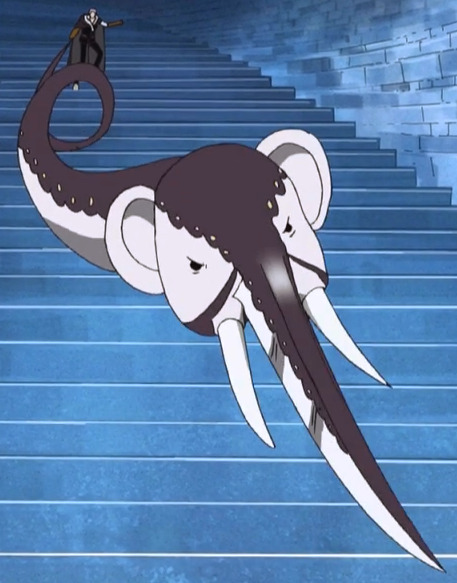
This is a sword who was fed an elephant like Zoan Fruit.
The only consequence though is that anyone who eats a fruit would forever lose their ability to swim and if placed in water would lose there powers and weaken them. Kinda like it's their kryptonite.
Also if you eat another Devil Fruit you will die from poisoning.
You can't always choose what Devil Fruit you get but it's always a lucky thing to find.
With that info I say that these are the fruits that would suit the Burns family and bots.
Captain Charlie Burns: The Noro Noro no Mi or Slow-Slow Fruit, great to slow down escaping riminals or panicked people, and in rescue work slow down any dangerous debry or disaster. Or the Nuke Nuke no Mi/Through-Through Fruit, which allows the users to walk or travel through any solid surface (kinda like a Phase Shifter).
Kade Burns: The Bomu Bomu no Mi/Bomb Bomb Fruit or Mera Mera no Mi/Fire Fire Fruit, both are good at suppressing fires and making its user fire/burn proof.
Dani Burns: Fuwa Fuwa no Mi/Float Float Fruit or Kiro Kiro no Mi/Kilo Kilo Fruit, both fruits would alow Dani to experience flight or fly herself and possibly other out of the way. Or the Hana-Hana no Mi/ Flower-Flower Fruit, allowing users to grow different limbs in separate place, Dani as a first responder and EMT could use an extra set of hands.
Graham Burns: Giro-Giro no Mi/ Glare-Glare Fruit which allows user to see through anything like X-Rays. Good for an engineer like Graham, another would be the Oshi Oshi no Mi/Push-Push Fruit that allows the user to push anything they want and at any size as if it were soft clay.
Cody Burns: Kibe-Kibe no Mi/Millet Millet Fruit might work well for Cody, given by using it he could feed anyone or any being his dango and immediately befriend them. He probably have a lot of fun with the Tori-Tori no Mi/ Bird-Bird Fruit Model Falcon, where he can turn into a Falcon or the Gum-Gum Fruit like Luffy so he can stretch in anyway he likes. Or the Chiyu-Chiyu/Heal-Heal Fruit, where he could heal those who are hurt with just his tears. Or maybe the Hiso-Hiso no Mi/Whisper-Whisper Fruit that allows them to hear the hearts of animals.
Now for the Rescue Bots
Heatwave: Moku Moku no Mi/Smoke-Smoke Fruit, not only does it allow its user to be a smokey cloud, but it also allows them to be impervious to most physical attacks Not to mention it can cancel out fires. Not to meantion user their smoke to trap or carry others. But maybe the Mera Mera no Mi could work for Heatwave, despite the name, would rather not be able to create fires.
Chase: Ori Ori no Mi/Cage Cage Fruit, which allows the user to create cage like bars from there arms and cuffs to trap opponents. Perfect for a cop/rule follower like Chase. Another is the Nagi Nagi no Mi/ the Calm Calm Fruit, which allows the user to create silence barrier or take all sound away from a certain areas. Something that Chase could use to confuse opponents or create control for a situation.
Blades: I think Blades would like the Mini-Mini no Mi/Mini-Mini Fruit, allowing the user to grow as small as they want. Blades loved being as small as Dani when he was in her body and would probably enjoy how he can buy so much human stuff now that he can be the right size for it. Or even become a real human with the Hito-Hito no Mi/Human-Human Fruit.
Boulder: I think that Boulder would live Oshi Oshi no Mi/Push-Push Fruit to push things far more gently that he could with his own plow. Or the Hito-Hito no Mi/Human-Human Fruit or Mini-Mini no Mi/Mini-Mini Fruit to be as small as a human or become one and enjoy being one as much as they like with everything included. Though he also might like the Ato-Ato no Mi/Art-Art Fruit🎨where he can create abstract art out of anything, but if he's not careful anyone too😅
I did my best but there are way more and feel free to mix and match for the ideal choice for each character. Feel free to check out the website to explore them more ✌️
11 notes
·
View notes
Text
All-Around Results after Qualifications Day 1
Here’s the top 24 after the first day of qualifications. Top 14 (without counting the 3 already qualified - Raffaeli, Varfolomeev and Nikolova) will win a quota for Paris 2024!
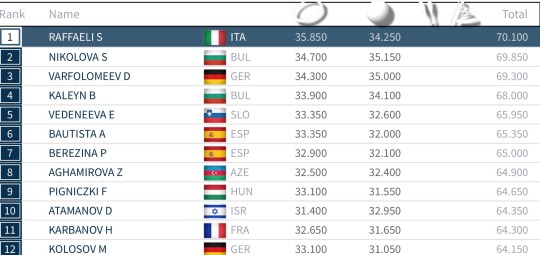
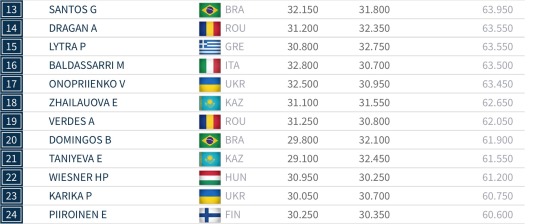
As expected a really strong showing from the Bulgarians and Kaleyn should have no problem securing the second spot for Bulgaria.
Raffaeli sits currently in first place, but not comfortably - Nikolova is only 0.250 behind her and Varfolomeev 0.800. The All-Around final will be one to remember! (Of course I can’t count Kaleyn out, but with a 68.000 she is sitting 1.3 points behind the podium).
Strong showing from Vedeneeva and she, too, should be able to comfortably secure a spot tomorrow (bar any huge disasters).
The Spanish were on fire🔥 today! (Both Bautista and Berezina and the fans), both sitting in the top 8 - 6th and 7th respectively, with Bautista securing a hoop final! If they keep up the good work they both should make it tomorrow!
Steady work from Zohra, as well, and she’s currently in 8th, with Fanni just 0.250 behind her. Strong hoop for Fanni, but she struggled a bit with ball.
Things aren’t looking too bright for Israel, both Atamanov and Katz having made mistakes. Atamanov is sitting in 10th position, but Katz is only 25th, with scores in the low 30s for both apparatus. A difficult, if not impossible job for Katz tomorrow to climb the ranks into top 14.
Karbanov was a huge surprise today! If she shows up tomorrow just as consistent as today, she’ll grab the quota for Paris! Not a great first day for Millet, however, with mistakes with both apparatus and currently sitting only 27th.
Kolosov will have to get it together tomorrow and not make any major mistakes; she had a drop with ball today and scored only a 31.050, but her strong hoop propelled her into 12th position.
Geovanna Santos showed some really strong work and is currently 13th. Unfortunately, after a strong start with ball (scoring a 32.100) Domingos had a massive disaster with hoop, scoring only a 29.800. Tough job for her tomorrow, as she’s currently in 20th place.
Dragan showed good work today, bar some small execution mistakes and she’s currently 14th. Sadly, after a good hoop which scored a 31.250, Verdes showed a shakey ball routine and while there were no major mistakes, she missed some of her difficulty; currently 19th.
Lytra is 15th, but had the potential of being much higher. Unfortunately, a missed hoop routine cost her dearly. Ball final for her today, however, having scored a great 32.750!
16th place for Milena as of today. Ball cost her dearly today and will have to give her all tomorrow. No major mistakes are allowed if she wants to secure the second quota for Italy.
Tough day for the Ukrainians as well, both Onopriienko and Karika having made huge mistakes. Viktoriia is 17th and Karika 23rd.
Taniyeva taniyevad today and managed an OOB with the hoop. Splendid ball routine, though, and we’ll see her in the final! Currently 21st.
Hanna Panna sits 22nd and Emmi Piiroinen rounds up the top 24.
10 notes
·
View notes
Note
*Unlike Wine, I'll experience everything before passing judgment. And besides, while it's not "high-class" in the way Wine is used to, it's got a charm about it*
How did you find out about this place Sans? It must be one of your favorites since you spoke of it so highly. You know the owner or something?
Sans: y-yea, uh it’s from my AU. Grillby and I, the owner, go way back.
He leans against the bar counter lazily greeting the older looking flame elemental.
Sans: hey grills~ can I get two menus? I got two newbies here, just the usual for me.
Grillby nods handing sans the papers who hands them to you two. Wine says a polite thank you and looks through it as you all sit down
Wine: hmm.. WHATS YOUR OPINION ON THE
He hides a small shudder
Wine: SLUG AND MUG?
The slug and mug on the menu is a slug steak burger that comes with a mug of warm millet beer. You inwardly wince knowing wines hatred for bug meat. Most of the menu items are bug of some sort but there is a chicken and beef burger too.
2 notes
·
View notes